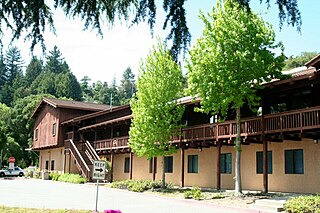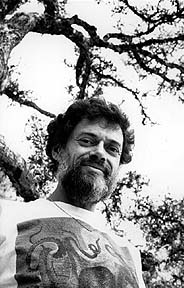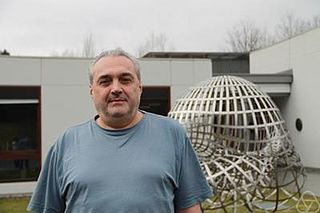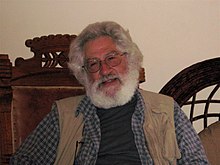
N,N-Dimethyltryptamine is a substituted tryptamine that occurs in many plants and animals, including humans, and which is both a derivative and a structural analog of tryptamine. DMT is used as a psychedelic drug and prepared by various cultures for ritual purposes as an entheogen.

Scotts Valley is a small city in Santa Cruz County, California, United States, about thirty miles (48 km) south of downtown San Jose and six miles (9.7 km) north of the city of Santa Cruz, in the upland slope of the Santa Cruz Mountains. As of the 2020 census, the city population was 12,224. Principal access to the city is supplied by State Route 17 that connects San Jose and Santa Cruz. The city was incorporated in 1966.

Alfred Rupert Sheldrake is an English author and parapsychology researcher. He proposed the concept of morphic resonance, a conjecture that lacks mainstream acceptance and has been widely criticized as pseudoscience. He has worked as a biochemist at Cambridge University, a Harvard scholar, a researcher at the Royal Society, and a plant physiologist for ICRISAT in India.

Mathematical physics refers to the development of mathematical methods for application to problems in physics. The Journal of Mathematical Physics defines the field as "the application of mathematics to problems in physics and the development of mathematical methods suitable for such applications and for the formulation of physical theories". An alternative definition would also include those mathematics that are inspired by physics, known as physical mathematics.

The Interplanetary Transport Network (ITN) is a collection of gravitationally determined pathways through the Solar System that require very little energy for an object to follow. The ITN makes particular use of Lagrange points as locations where trajectories through space can be redirected using little or no energy. These points have the peculiar property of allowing objects to orbit around them, despite lacking an object to orbit. While it would use little energy, transport along the network would take a long time.

Terence Kemp McKenna was an American ethnobotanist and mystic who advocated the responsible use of naturally occurring psychedelic plants. He spoke and wrote about a variety of subjects, including psychedelic drugs, plant-based entheogens, shamanism, metaphysics, alchemy, language, philosophy, culture, technology, ethnomycology, environmentalism, and the theoretical origins of human consciousness. He was called the "Timothy Leary of the '90s", "one of the leading authorities on the ontological foundations of shamanism", and the "intellectual voice of rave culture".

Sir Harold Jeffreys, FRS was a British geophysicist who made significant contributions to mathematics and statistics. His book, Theory of Probability, which was first published in 1939, played an important role in the revival of the objective Bayesian view of probability.

Dynamical systems theory is an area of mathematics used to describe the behavior of complex dynamical systems, usually by employing differential equations or difference equations. When differential equations are employed, the theory is called continuous dynamical systems. From a physical point of view, continuous dynamical systems is a generalization of classical mechanics, a generalization where the equations of motion are postulated directly and are not constrained to be Euler–Lagrange equations of a least action principle. When difference equations are employed, the theory is called discrete dynamical systems. When the time variable runs over a set that is discrete over some intervals and continuous over other intervals or is any arbitrary time-set such as a Cantor set, one gets dynamic equations on time scales. Some situations may also be modeled by mixed operators, such as differential-difference equations.

Dennis Jon McKenna is an American ethnopharmacologist, research pharmacognosist, lecturer and author. He is the brother of well-known psychedelics proponent Terence McKenna and is a founding board member and the director of ethnopharmacology at the Heffter Research Institute, a non-profit organization concerned with the investigation of the potential therapeutic uses of psychedelic medicines.

Rick Strassman is an American clinical associate professor of psychiatry at the University of New Mexico School of Medicine. He has held a fellowship in clinical psychopharmacology research at the University of California San Diego and was Professor of Psychiatry for eleven years at the University of New Mexico. After 20 years of intermission, Strassman was the first person in the United States to undertake human research with psychedelic, hallucinogenic, or entheogenic substances with his research on N,N-dimethyltryptamine, also known as DMT. He is also the author of DMT: The Spirit Molecule, which summarizes his academic research into DMT and other experimental studies of it, and includes his own reflections and conclusions based on this research.

Jerrold Eldon Marsden was a Canadian mathematician. He was the Carl F. Braun Professor of Engineering and Control & Dynamical Systems at the California Institute of Technology. Marsden is listed as an ISI highly cited researcher.

Alan David Weinstein is a professor of mathematics at the University of California, Berkeley, working in the field of differential geometry, and especially in Poisson geometry.

The stoned ape theory is a controversial theory first proposed by American ethnobotanist and mystic Terence McKenna in his 1992 book Food of the Gods. The theory claims that the transition from Homo erectus to Homo sapiens and the cognitive revolution was caused by the addition of psilocybin mushrooms, specifically the mushroom Psilocybe cubensis, into the human diet around 100,000 years ago. Using evidence largely based on studies from Roland L. Fischer et al. from the 1960s and 1970s, he attributed much of the mental strides made by humans during the cognitive revolution to the effects of psilocybin intake found by Fischer.
Robert Stetson Shaw is an American physicist who was part of Eudaemonic Enterprises in Santa Cruz in the late 1970s and early 1980s. In 1988 he was awarded a MacArthur Fellowship for his work in chaos theory.
James P. Crutchfield is an American mathematician and physicist. He received his B.A. summa cum laude in physics and mathematics from the University of California, Santa Cruz, in 1979 and his Ph.D. in physics there in 1983. He is currently a professor of physics at the University of California, Davis, where he is director of the Complexity Sciences Center—a new research and graduate program in complex systems. Prior to this, he was research professor at the Santa Fe Institute for many years, where he ran the Dynamics of Learning Group and SFI's Network Dynamics Program. From 1985 to 1997, he was a research physicist in the physics department at the University of California, Berkeley. He has been a visiting research professor at the Sloan Center for Theoretical Neurobiology, University of California, San Francisco; a postdoctoral fellow of the Miller Institute for Basic Research in Science at UCB; a UCB physics department IBM postdoctoral fellow in condensed matter physics; a distinguished visiting research professor of the Beckman Institute at the University of Illinois, Urbana-Champaign; and a Bernard Osher Fellow at the San Francisco Exploratorium.

David Jay Brown is an American writer and interviewer. Brown has studied parapsychology and the effects of psychoactive drugs. With parapsychologist Rupert Sheldrake, he studied pets and people who apparently anticipate events. Brown has served as a guest editor for the Multidisciplinary Association for Psychedelic Studies (MAPS), and he has published many interviews of prominent thinkers.
Geometric mechanics is a branch of mathematics applying particular geometric methods to many areas of mechanics, from mechanics of particles and rigid bodies to fluid mechanics and control theory.

Tudor Stefan Rațiu is a Romanian-American mathematician who has made contributions to geometric mechanics and dynamical systems theory.
Anthony Joseph Tromba is an American mathematician, specializing in partial differential equations, differential geometry, and the calculus of variations.















